
Chapter 13
New Devices For New Deeds
The Crawler - Transporter
The four unique structures going up on Merritt Island - the vehicle assembly building, the launch control center, the central instrumentation facility, and the operations and checkout building - had their match for distinctiveness in a group of devices being designed and built at the same time: the crawler-transporter, the mobile launcher, the mobile service structure, and the service arms. These novel mechanisms almost defy verbal description, and the reader should refer frequently to the illustrations in this chapter.
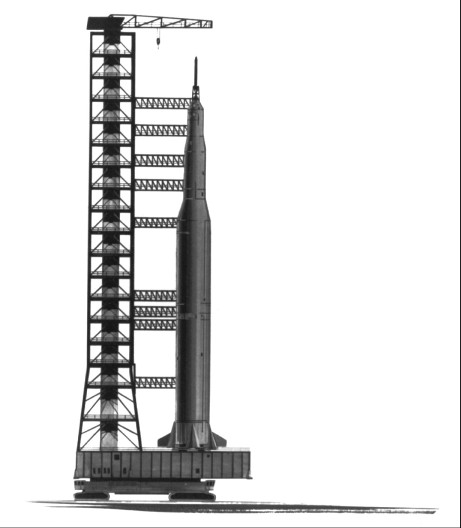
Sketch of Saturn V and mobile launcher on a crawler-transporter, November 1963.
Something like the crawler-transporters that would eventually move the Apollo-Saturns from the VAB to the launch pads of LC-39 had been used for surface coal mining in Paradise, Kentucky [see chapter 6-3]. These huge vehicles ran on four tank-like treads, much like bulldozer treads in shape, but considerably larger. One of these double-track mechanisms supported the vehicle at each corner. Since Bucyrus-Erie of Milwaukee was the only firm that had built such giant contrivances, the Launch Operations Center (LOC) sent engineers to inspect them in Kentucky and the Bucyrus-Erie plant in Wisconsin.1 LOC moved toward closing a contract with the Milwaukee firm, as the only company that could build the crawlers in the allotted time. Approval by NASA Headquarters seemed assured.2
Negotiations, however, did not prove so simple. A Bucyrus-Erie employee, Barrett Schlenk, had first interested LOC in using the crawler to carry the spaceship from the VAB to the pad. But when it appeared that Bucyrus-Erie would get the contract under sole-source procurement, William C. Dwyer, Vice President of Marion Power Shovel Co. of Ohio, protested to NASA. Brainerd Holmes urged Debus to use competitive bidding. Twenty two industrial firms sent representatives to a procurement conference, but only two submitted proposals - Marion for 8 million dollars, Bucyrus-Erie for 11 million dollars.3
Now Senator William Proxmire (D., Wis.) protested. Webb met with him and other members of Congress to discuss the matter. Previously, Proxmire had tried in vain to amend the NASA Authorization Bill for fiscal 1963 to require competitive bidding to the "maximum possible extent" [see chapter 8-4]; but now he advanced the cause of a Wisconsin firm, even though it had lost out in competitive bidding. He questioned the validity of Marion's estimate of an 8-million-dollar cost for the crawler-transporter. Congressman Henry Reuss (D., Wis.) next urged a fixed-price contract to hold Marion to its estimate. But Webb countered that continual modifications would come during construction and insisted on the cost-plus contract.4
A second major factor in Marion's favor, besides its considerably lower bid, was its announced intention of choosing a project manager from its own personnel, thus saving considerable time in building a team.5 Bucyrus had said it would bring in one from outside. Having received the contract, Marion selected a competent manager, Philip Koehring, not from its own company, but from - of all firms - Bucyrus-Erie. When Marion finally completed the contract two years later, the price had risen above 11 million dollars.
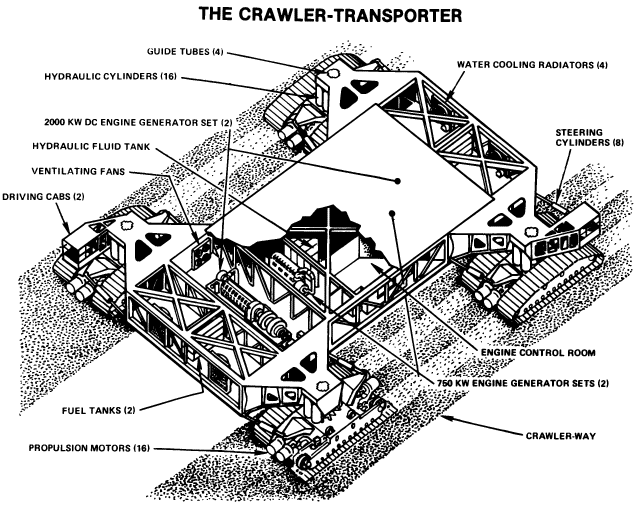
Schematic of the crawler-transporter.
By contract, Marion undertook to assemble the first complete crawler-transporter on Merritt Island by 1 November 1964 and finish road tests, mating, and modifications by 1 March 1965.6 By early December 1963, Marion had completed 90% of the design and promised that parts of the vehicle would begin to arrive at the launch area - now the Kennedy Space Center - in March 1964.7
In the meantime, Marion had run into trouble with one of its subcontractors, American Machine & Foundry, over the hydraulic system for steering and levelling the crawler.8 Balancing a 5,400- metric-ton load called for precision. The motion of the transporter, the height of the load, variations in the level of the roadway , the wind - all would combine to throw the cargo off balance. Marion hired Bendix Corporation to check the levelling and equalization systems on the crawler. The Bendix study, made by mathematician-inventor Edward Kolesa, criticized the levelling systems as too quick and sensitive in their actions. The difficulties between Marion and its subcontractor were not the direct responsibility of KSC. Nevertheless, KSC sent the Bendix study to General Electric for analysis. The GE experts agreed with Kolesa's calculations.9 As a result, Marion had to adjust the designs. Among other things, a separate power system, distinct from the diesel engines that powered the treads, was added for load-levelling, jacking, steering, and ventilating.
"Prophetically," said an article in Aviation Week sometime later, "NASA early identified the transporter as the one item which would most likely encounter trouble and whose development, therefore, should be started as soon as possible."10 One set of problems arose from a factor in Marion's background. The company had previously held few government contracts and its management lacked familiarity with the intricate procedures and tests that a government contract entailed. Marion had to hire new men to carry out the new procedures, which resulted-in unexpected costs.11
Marion was to have the first of the two units ready for testing in the late fall of 1964, although it was to make its initial trip in April 1965. In the meantime, the monster ran into another snag: someone noted that it had no fire alarm system or fire detection devices. With flammable materials and extensive electronics and mechanical equipment aboard, an alarm system was needed when the crawler was not in use.12 As first designed, the crawler-transporter would carry only dry chemical extinguishers.13
After considerable correspondence during the spring of 1965, the Factory Insurance Association of Hartford made a complete study of fire protection on the crawler. Fifteen recommendations for fire safety included an automatic carbon dioxide extinguishing system for the electrical control room, the entire engine room, and the hydraulic equipment compartment; a limited, automatic sprinkler system as backup protection for the carbon dioxide system; an automatic, total-flooding foam system; flexible water connections to the sprinkler and hose systems in the transporter parking area; meticulous housekeeping and cleanliness inside the crawler-transporter; and the use of 100% noncombustible materials in all future construction and modifications to the crawler-transporter.14 The contractor set about putting in a satisfactory fire prevention system.
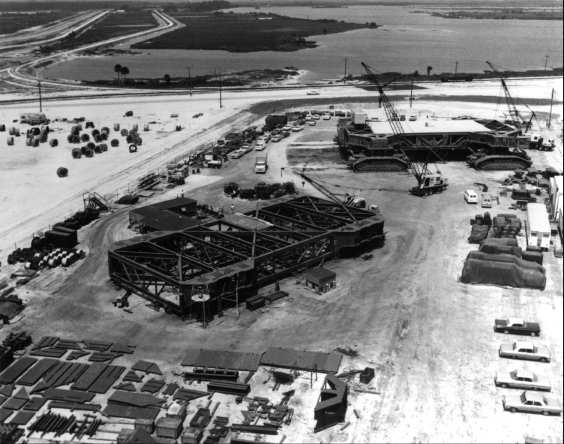
Crawler-transporters under construction, April 1965.
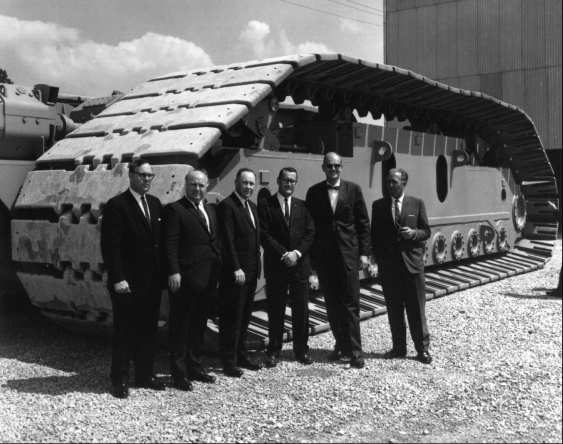
Richard L. Drollinger, Director of Engineering, Marion Power Shovel Co.; Theodor A. Poppel and Donald D. Buchanan, both of KSC; S. J. Fruin, Executive Vice President, Marion; Philip Koehring, Project Engineer, Marion; and Kurt H. Debus, KSC, in front of a crawler truck at Marion, Ohio, in July 1964. The group observed the first test of the vehicle.
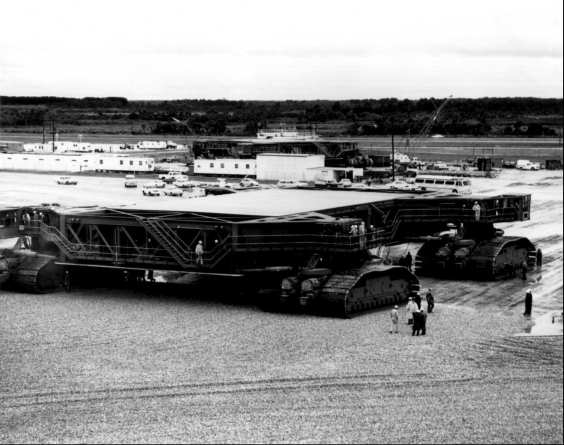
The first crawler-transporter ready for service, January 1966.
When finally assembled, the crawler-transporter would not have won any awards for beauty. From a distance it looked like a steel sandwich held up at the corners by World War I tanks. Each crawler- transporter was larger than a baseball infield and weighed about 2,700 metric tons. Two 2,750 horsepower diesel engines powered 16 traction motors, which moved the four double-tracked treads. Each tread had 57 "shoes." Each shoe, 0.3 x 2.3 meters, weighed close to 900 kilograms. Quite naturally, a great deal of experiment and readjustment preceded the final success of such treads. Because of their importance and cost, they were nicknamed, "Them Golden Slippers." Many people recalled the next line of that song: "Golden shoes I'm going to wear, to walk that golden street."15 The crawlerway would be such a street.
| Next |